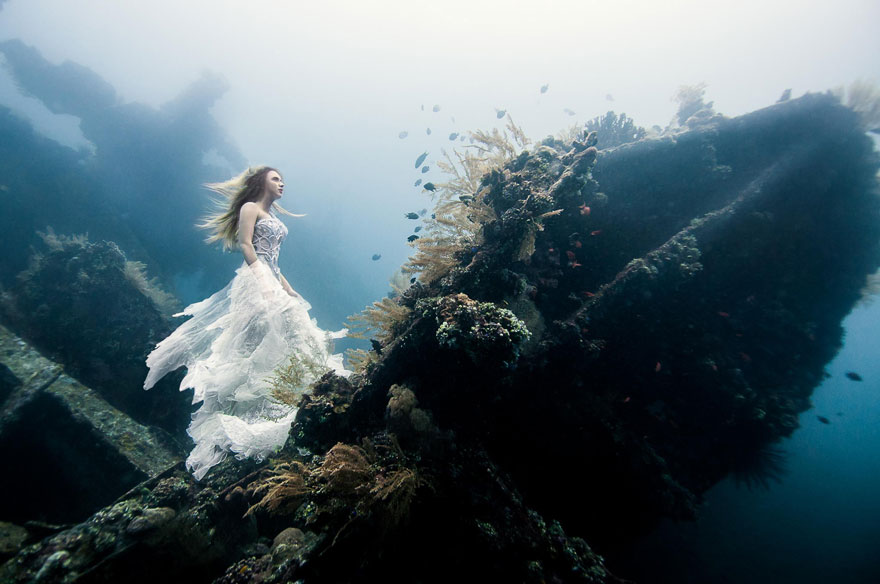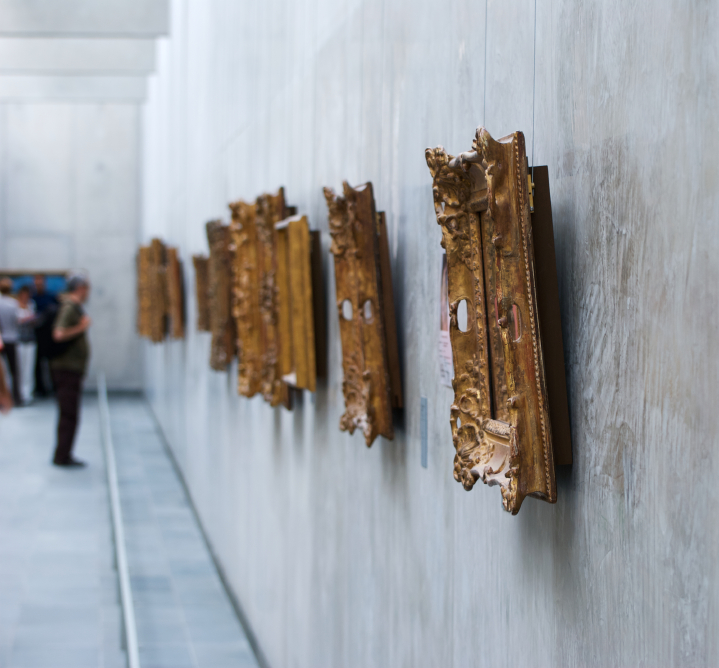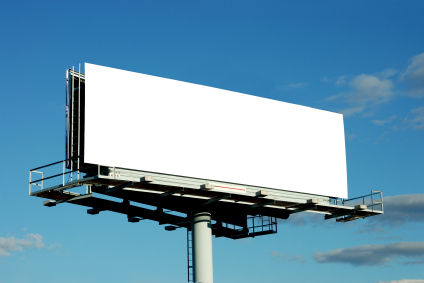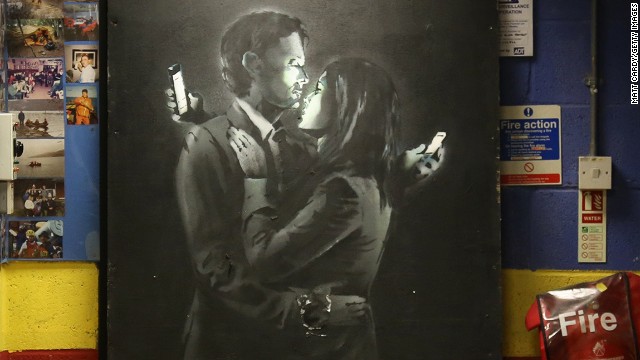Friday 30th May 2014Artist Spotlight: Benjamin Von Wong
A few weeks ago, we took a look at the work of Seoul-based photographer JeeYoung Lee, who creates personally cathartic dreamscapes in her miniature studio. Today, we're going to take a look at the work of Benjamin Von Wong, which follows similar principles to Lee's work. Von Wong creates exceptionally dramatic and dreamlike images, but all without the use of Photoshop or any other kind of digital manipulation. Instead, he creates truly elaborate scenes, with painstaking attention to detail.

In the example shown above (image credit, naturally, goes to Benjamin Von Wong), one of his most recent photoshoots took place at a long-abandoned shipwreck off the coast of Bali, Indonesia - entirely underwater. It took an enormous crew of divers and models to pull off, and the photographs they produced were absolutely breathtaking. Because the models couldn't be festooned with scuba gear and the shipwreck was in fairly deep water, the solution presented itself in the form of freedivers. Freediving is the apparently exhilarating sport of extreme depth diving without any equipment, making them perfect candidates for models in great shape with the ability to hold their breath for extended periods in shark-infested waters, a remarkably specific set of requirements for a photoshoot.
Interestingly, Von Wong originally got his photographic start in Montreal, Canada, but after building a fan base on Facebook and Twitter, he was able to gather some Kickstarter funding to send him on a photographic odyssey throughout Europe. This should help give those of you aspiring to an artistic career the real value of social media, as the fanbase he established there allowed him to quit his day job and devote himself to photography fulltime.
He also was very careful in his use of the stories behind his shots, creating hit 'making of' videos that were released on YouTube to widespread interest. Due to the elaborate care that he takes in each and every step of his photoshoots, he was set to capitalize on the interest that art viewers always seem to express in the stories behind the images they enjoy.
As he explained to Digital Photography Review when asked how he built his fan-base, he said, "The same way that you come up with fans on any network, you just stay very active. I was shooting a lot. I was putting up almost a photograph a day." Social media can be a powerful tool, but it has to be used in the right way: regularly!
Posted on May 30th 2014 on 10:06pm
0 Comments
Tuesday 27th May 2014How the Art World Creates Value

The value of art is a funny thing. The value of anything is determined by any number of factors, naturally, but as we saw with the advent of impressionist painting, value is no longer inherently about the technical skills employed in accurately representing the world around us. As in almost all other areas of the world, the art community establishes value based on a fairly random set of criteria. As we've seen lately, many of the world's most famous works command incredibly high prices, regardless of whether or not you accept the premise that the art world is experiencing a sales bubble.
Philip Hook, a leading art expert and a senior director at Sotheby's auction house, has put his finger on a number of circumstances that help create the seemingly-inflated prices that these works command. Interestingly, the majority of them tend to be related to the story behind the work itself, rather than specifically about the content or style. As we've discussed in previous posts, you can take advantage of this with some judicious self-promotion. By sharing the narrative of your artistic life, and how that intersects with and influences the rest of your life, can create a much more interesting story than the work would in a vacuum.
Consider Van Gogh: a world-renowned painter whose works command incredible prices at auction houses during the rare changes of ownership they see every few decades. But without the famous story of his anguish over his art, his depression, the self-mutilation of his ear and his eventual tragic suicide, would his work still command the respect and admiration that it does today? Perhaps, but there were a number of other artists whose work could easily be the ones revered in galleries throughout the world instead of Van Gogh.
This is not to say that you should be willing to hurt yourself or do anything permanently drastic just to make your art potentially valuable, but being aware of the power of narrative to shape the value of your work (both fiscally and perceptually) can be a very helpful tool in your artistic career. Many beginning artists are paradoxically shy about sharing the more intimate details of their lives, despite being inherently invested in expressive tendencies, and the sooner you can shake this habit, the sooner you'll be able to start taking advantage of your own ability to create works of value.
Posted on May 27th 2014 on 10:03pm
0 Comments
Friday 23rd May 2014Mac or PC for Your Digital Art?
One of the bitterest rivalries that has consumed generations of digital artists is the divide between the Mac and the PC. Okay, that might be a touch hyperbolic, as they haven't existed in their present incarnations for more than a generation, but there are still bitter feuds and harsh words exchanged between the two opposing camps. When the time comes to buy yourself a new computer, it's an important decision to make. Switching between the two can be something of a hassle, but it's not impossible, although as long as Adobe and other software makers are unwilling to allow their customers to switch platforms without purchasing additional copies of programs, that can be a major added expense when it comes to switching environments.
That being said, Macs have a long tradition of being used by the more creative types of personalities (although how much of that tendency is really justified and how much of it comes from Apple's exceptional marketing capabilities is really up for debate). In the hazy days of yore when even the most basic computer cost thousands of dollars, there was a real advantage for artists to use Macs. They paid closer attention to design, displayed colours more accurately than PCs of the day, and worked easily with Postscript printers.
Those days are past - long past, in fact. At this particular moment, 95% of the internal components of Macs are exactly the same as they are in PCs, and PCs tend to be capable of running anything that a Mac can with equal facility. Adobe has improved the PC versions of their products (Photoshop, Illustrator, and InDesign, among many others) to be completely on par with the Mac versions, and PC monitors now offer exactly the same colour fidelity that Mac screens do.
The next major concern, of course, is price. We artists tend not to be rolling in cash, although we are also very conscious of image (even though we often pretend not to be). This tends to make us lean towards Macs anyways, simply because they have a cachet that PCs don't, but when you're on a budget, 9 times out of 10 you can get a PC that will run circles around a Mac at a similar price - not to mention that the cheapest Macs available tend to approach the $1000 price point, while a perfectly serviceable PC can be had for half that price.
Naturally, there are some caveats, but at this point, the long-fought battle between the two can be said to be little more than marketing hype. Ultimately, it all comes down to what you're most comfortable with, as 99% of your digital artwork will be completed equally well on either platform. If you're into high-end video editing, you may be better off with a Mac, whereas if your emphasis is on 3D rendering, you may be better off with a PC. It all comes down to what you need, not which is better.
Posted on May 23rd 2014 on 07:13pm
0 Comments
Wednesday 21st May 2014How Far is Too Far?

Almost inherently, art is about reactions. Whether it's the hint of the sublime you feel from viewing the works of an old master, the shiver of creeping horror you feel from photo essays on wars, or the button pushing jokes of performance artists, it's all designed to provoke some type of reaction from the viewer. This reaction can have various goals, of course, but it seems almost inevitable that it has one - even if the goal isn't found within the work itself, as in the case of so many contemporary projects that emphasise the variations of response that individual interpretations can create, it can be found in the exploration of said interpretations. Art asks us to think. When heading down the long road towards overcoming the reactions of the jaded art world and reaching through into the mainstream consciousness, how far is too far?
The question grows ever more relevant in a world that is so bombarded with messages, both artistic and advertised, politically, spiritually, and economically, that artists are stepping up their game in order to make waves. Take the case of Alexander Selvik Wengshoel, a Norwegian artists who recently made headlines with a uniquely disturbing project he submitted for his graduate exhibition from art school. Recent art school graduates are notorious for ridiculously idiotic and asinine exhibits, but Wengshoel's project falls more on the disturbing side of the line.
Born with a deformed hip that many surgeries failed to correct, he finally underwent a surgery that changed everything, and replaced his hip with a metal prosthetic that enabled him to leave his wheelchair and crutches behind. It also left him with a piece of his own hip, which he took home from the hospital. After a (remarkably small) bit of careful deliberation, he ate the meat from his hip, and submitted the bone as his graduate exhibit. Yes, you read that correctly.
So we come back to the question of, 'How far is too far?' Wengshoel's rationale for the project is to explore the boundaries of personal space and what we can do with our own bodies, but this writer is a little suspicious of the seemingly -- if you'll pardon the expression -- unfleshed-out themes and explanation. He certainly grabbed headlines around the world, but did he go too far? Or is the simple fact that his submission is making us ask these questions enough of a justification for it in and of itself?
Posted on May 21st 2014 on 02:55pm
0 Comments
Friday 16th May 2014Artist Spotlight: Mark Flood

Contemporary art pulls us in a lot of directions at once. The sheer number of artists working in the world at any given time is pretty impressive, which means it takes a great deal of either luck, skill, persistence or a blend of all three to make sure your signal cuts through the noise. This series is dedicated to helping bring to light artists both artists that are doing exciting, remarkable, or ridiculous things to light, and those who haven't yet reached critical media mass.
Mark Flood has been an active artist for quite a long time, yet he was only brought to our attention last week due to his recent project in New York City, which he has dubbed the Insider Art Fair. As those of you who are relatively familiar with the art world are likely to know, so-called 'outsider art' refers to art created by those artists who are working outside of modern Western mainstream contemporary art (often code for post-colonial artists, those who are dealing with themes outside of the scope of most artists work, and others who appeal to the irritatingly jaded palates of said Western art world). Insider art, by extension, is from an artist working from within the very depths of contemporary Western art and all the history that implies.
Flood's "art fair" is really an exhibition, but one that not only provides interesting pieces derived from the world and sensibilities that informed the development of his style, but also as an indictment of the entire concept of art fairs, where the general attitude is to sell as much as possible as quickly as possible. The pieces tend to be caustic send-ups of both the art world and the corporate influences that have infected much of American art over the last several decades, and Flood appears unashamed and unapologetic, although as with an joke, it can sometimes be hard to tell who it's being played on.
When interviewed by the Gallerist at the Insider Art Fair, he said, "All the roles are breaking down. The collectors are curators, the museums are auction houses. I went to Frieze. I don’t have any problems with art fairs. For me, the fundamental issue as an artist at a fair is you don’t get to control the context of the work. Artists will have to take control, like always."
Here's hoping he can pull it off - or maybe the joke's on us.
Posted on May 16th 2014 on 02:36pm
0 Comments
Tuesday 13th May 2014Art al Fresco

There is a disappointing trend emerging in the American cultural world. Perhaps not surprising in concept, but the numbers are a bit unnerving: only 21% of American adults have visited a gallery or museum in the past year, but over 80% have visited a fast food restaurant over the course of the previous week (though no word as yet about whether or not there is a correlation between the two ;-) ). While it may be easy to decry the loss of American culture, ditching the Whistler for Honey Boo Boo, a project has sprung up in America that seeks to bring artwork by famous American artists back to the forefront of the American landscape, both culturally and literally.
Based off a successful project that took place in the United Kingdom in 2013, the American version is titled 'Art Everywhere US', and aims to place works by prominent American artists on billboards across the nation. The British project replaced 22,000 billboards around the UK with works by British artists, and the American version is ready to top that this summer, with what will be the world's largest outdoor art exhibition, with over 50,000 billboards converted into artistic masterpieces.
Five museums are participating in the project to help raise awareness: LACMA, the Whitney Museum of American Art, the Art Institute of Chicago, the Dallas Museum of Art, and the National Gallery of Art have each put forward 20 pieces from their collection for consideration. An online voting poll will determine a final 50 pieces that will be placed all around the country.
"I think part of the idea behind the whole project is to put art in unexpected places and encourage those double-takes," says the CCO of the Whitney Museum of American Art, Jeff Levine, in an interview with Fast Company. "I have this image of driving on Route 66 in a convertible and seeing a Georgia O’Keefe billboard,” he adds. “I think for some of these artists whose work is actually geographically specific, some of the possibilities are really incredible."
Hopefully, it will spur increased interest in the arts, although it's hard to say if the downswing in gallery attendance really marks a decline in interest in art itself, or simply a decline in the interest of visiting a gallery. In an age of choice, the notion of curated content can be a bit off-putting to some, especially those art enthusiasts in younger demographics.
Posted on May 13th 2014 on 08:11pm
0 Comments
Saturday 10th May 2014Choosing the Right Monitor

For many artists working in the various digital media, there is one thing they can't live without - a good computer! For some people, a laptop offers the best balance of portability and power, but in many cases a laptop can't provide the raw power necessary for working with extremely large and complex files. This leaves them with the choice among desktop computers, which tend to offer a great deal of flexibility and customisability, as well as the capacity for truly impressive computing power. For a digital artist, one of the most important choices in a computer setup is the monitor.
Even for those artists who choose a laptop, the amount of available screen real estate can often be a huge productivity block. Almost all laptops offer some kind of functionality for attaching an additional monitor, which can dramatically improve your workflow. But what to buy? There are a bewildering number of options available, and tons of competing technologies. Fortunately, we can help you wade through the hype and get to what really matters.
There are a couple of basic decisions that you have to make when you're buying a monitor. Primarily, what kind of connection does your computer require? DVI (digital video interface) and HDMI are the most common, but VGA connectors are also common on older laptops. You can check out your laptop or your video card to see what connectors you've got to work with.
Once you've sorted that out, the next step is to choose the right size. If you commonly work with extremely large digital images in minute detail, naturally the bigger the monitor the better, as you'll be able to zoom in close and work more freely with them, but it's important to consider your available desk space at the same time.
Next, consider the quality of the pixels in the monitor itself. Dot pitch determines how close the pixels are to each other in the monitor, and the higher the dot pitch, the clearer the image will seem. Be sure to also consider the maximum brightness of the monitor, measured in 'nits', although if you're intending to do much work for print, you'll be adjusting these settings well below the maximum capability in order to get accurate colour representations.
Once you've chosen your monitor, make sure you take the time to use a colourimeter to calibrate your screen!
Posted on May 10th 2014 on 08:08pm
0 Comments
Wednesday 07th May 2014The Big Questions: Why Do You Create?

Some time, at some point in their lives or their artistic careers (or both), everyone asks themselves, "What's the point of art?" Whether it's in a moment of frustration at a creative block or a depression after an unfortunate gallery turnout or just an idle moment of procrastination in the studio, the question has probably crossed your mind. Art critics tend to be willing to comment about individual pieces and individual artists, but it's a much more complicated topic to look at art as whole.
Largely, this is because art doesn't have a single, unifying purpose, unless that purpose is simply to communicate. Every piece has something to say, even if it's entire purpose is to deliberately avoid saying something. But that's a fairly simple surface answer, which can be picked apart to reveal a whole range of reasons and rationalisations.
It's one of the most important questions for you to be able to answer, as an artist. The next time you find yourself with a creative block, take a step back from your work and re-examine what you're hoping to achieve with your work. It can be a scary question, especially if you're just starting out and you haven't really given it much thought before, but it's incredibly helpful in many ways. Not only does it give you a direction for future pieces, it also allows you to talk about your completed individual pieces and your entire body of work in a way that appeals to buyers and collectors alike. It helps give your work character and history.
If you're trying to answer this question for the first time, there are a few things to think about that might help you figure out what the purpose of your art is. It might simply be that you love to try new things and new techniques, but once you begin to become comfortable with them, you'll find yourself beginning to more closely examine the emotional weight behind your art. For some artists, creation is a catharsis, an emotional tool that gives vent to feelings that are difficult or impossible to express with words. For some artists, the simple act of creation is enough. For some artists, adding a bit of beauty to the world is all they require. But no matter what your reasons are, it's important that you understand them, as they will allow you to better understand yourself and your relationship with the art world.
Posted on May 07th 2014 on 05:40pm
0 Comments
Friday 02nd May 2014A Bit More Banksy

By now, it's almost inevitable that you've heard of the street artist named Banksy. Whether just from reading this blog, or your own personal interest in his work, it's impossible to deny the fact that he has been one of the major driving forces behind the acceptance of street art into the world of high culture. After getting a start 20 years ago in Bristol, UK, Banksy has since graced some of the world's leading art galleries and auction houses with his work, all while maintaining a sly sense of notoriety - though whether or not this can be considered more than a marketing ploy at this point is up for debate.
One of the most interesting consequences of his style of work, however, is the question of ownership. If a kid with a spray can and a stencil creates a piece of work, typically it's either ignored, or eventually removed by a town council's anti-graffiti group. When the artist behind a stenciled piece is an internationally renowned figure, however, people start to sit up and take notice.
But who owns the piece? If Banksy had created his work on canvas he bought, naturally he would be considered the owner by copyright law. But considering that he uses real property that belongs to someone else (and without their consent), does the piece automatically become the property of the owner of the building or structure that acts as canvas?
This question was recently highlighted by a Banksy piece that appeared on the wall of a community centre in Bristol, back where the phenom got his start. The piece, which was apparently titled 'Mobile Lovers', was initially released in an Instagram photo, which fans finally tracked down to the Broad Plain Boys youth centre using digital sleuthing techniques that included Google Street View.
Within a few hours of the piece being properly discovered, however, members of the youth centre had removed it from the wall with a crowbar and set it up inside. While they are allowing anyone free access to view the piece, they are requesting a voluntary donation to help keep the centre up and running.
It will be interesting to see what they plan to do with the piece in the long term, as Banksy originals have been fetching large sums of money at auction houses all over the world - although there may be some complex legal implications if they do attempt to auction the piece.
Posted on May 02nd 2014 on 05:23pm
0 Comments

 The value of art is a funny thing. The value of anything is determined by any number of factors, naturally, but as we saw with the advent of impressionist painting, value is no longer inherently about the technical skills employed in accurately representing the world around us. As in almost all other areas of the world, the art community establishes value based on a fairly random set of criteria. As we've seen lately, many of the world's most famous works command incredibly high prices, regardless of whether or not you accept the premise that the art world is experiencing a sales bubble.
The value of art is a funny thing. The value of anything is determined by any number of factors, naturally, but as we saw with the advent of impressionist painting, value is no longer inherently about the technical skills employed in accurately representing the world around us. As in almost all other areas of the world, the art community establishes value based on a fairly random set of criteria. As we've seen lately, many of the world's most famous works command incredibly high prices, regardless of whether or not you accept the premise that the art world is experiencing a sales bubble. One of the bitterest rivalries that has consumed generations of digital artists is the divide between the Mac and the PC. Okay, that might be a touch hyperbolic, as they haven't existed in their present incarnations for more than a generation, but there are still bitter feuds and harsh words exchanged between the two opposing camps. When the time comes to buy yourself a new computer, it's an important decision to make. Switching between the two can be something of a hassle, but it's not impossible, although as long as Adobe and other software makers are unwilling to allow their customers to switch platforms without purchasing additional copies of programs, that can be a major added expense when it comes to switching environments.
One of the bitterest rivalries that has consumed generations of digital artists is the divide between the Mac and the PC. Okay, that might be a touch hyperbolic, as they haven't existed in their present incarnations for more than a generation, but there are still bitter feuds and harsh words exchanged between the two opposing camps. When the time comes to buy yourself a new computer, it's an important decision to make. Switching between the two can be something of a hassle, but it's not impossible, although as long as Adobe and other software makers are unwilling to allow their customers to switch platforms without purchasing additional copies of programs, that can be a major added expense when it comes to switching environments. Almost inherently, art is about reactions. Whether it's the hint of the sublime you feel from viewing the works of an old master, the shiver of creeping horror you feel from photo essays on wars, or the button pushing jokes of performance artists, it's all designed to provoke some type of reaction from the viewer. This reaction can have various goals, of course, but it seems almost inevitable that it has one - even if the goal isn't found within the work itself, as in the case of so many contemporary projects that emphasise the variations of response that individual interpretations can create, it can be found in the exploration of said interpretations. Art asks us to think. When heading down the long road towards overcoming the reactions of the jaded art world and reaching through into the mainstream consciousness, how far is too far?
Almost inherently, art is about reactions. Whether it's the hint of the sublime you feel from viewing the works of an old master, the shiver of creeping horror you feel from photo essays on wars, or the button pushing jokes of performance artists, it's all designed to provoke some type of reaction from the viewer. This reaction can have various goals, of course, but it seems almost inevitable that it has one - even if the goal isn't found within the work itself, as in the case of so many contemporary projects that emphasise the variations of response that individual interpretations can create, it can be found in the exploration of said interpretations. Art asks us to think. When heading down the long road towards overcoming the reactions of the jaded art world and reaching through into the mainstream consciousness, how far is too far? Contemporary art pulls us in a lot of directions at once. The sheer number of artists working in the world at any given time is pretty impressive, which means it takes a great deal of either luck, skill, persistence or a blend of all three to make sure your signal cuts through the noise. This series is dedicated to helping bring to light artists both artists that are doing exciting, remarkable, or ridiculous things to light, and those who haven't yet reached critical media mass.
Contemporary art pulls us in a lot of directions at once. The sheer number of artists working in the world at any given time is pretty impressive, which means it takes a great deal of either luck, skill, persistence or a blend of all three to make sure your signal cuts through the noise. This series is dedicated to helping bring to light artists both artists that are doing exciting, remarkable, or ridiculous things to light, and those who haven't yet reached critical media mass. There is a disappointing trend emerging in the American cultural world. Perhaps not surprising in concept, but the numbers are a bit unnerving: only 21% of American adults have visited a gallery or museum in the past year, but over 80% have visited a fast food restaurant over the course of the previous week (though no word as yet about whether or not there is a correlation between the two ;-) ). While it may be easy to decry the loss of American culture, ditching the Whistler for Honey Boo Boo, a project has sprung up in America that seeks to bring artwork by famous American artists back to the forefront of the American landscape, both culturally and literally.
There is a disappointing trend emerging in the American cultural world. Perhaps not surprising in concept, but the numbers are a bit unnerving: only 21% of American adults have visited a gallery or museum in the past year, but over 80% have visited a fast food restaurant over the course of the previous week (though no word as yet about whether or not there is a correlation between the two ;-) ). While it may be easy to decry the loss of American culture, ditching the Whistler for Honey Boo Boo, a project has sprung up in America that seeks to bring artwork by famous American artists back to the forefront of the American landscape, both culturally and literally. For many artists working in the various digital media, there is one thing they can't live without - a good computer! For some people, a laptop offers the best balance of portability and power, but in many cases a laptop can't provide the raw power necessary for working with extremely large and complex files. This leaves them with the choice among desktop computers, which tend to offer a great deal of flexibility and customisability, as well as the capacity for truly impressive computing power. For a digital artist, one of the most important choices in a computer setup is the monitor.
For many artists working in the various digital media, there is one thing they can't live without - a good computer! For some people, a laptop offers the best balance of portability and power, but in many cases a laptop can't provide the raw power necessary for working with extremely large and complex files. This leaves them with the choice among desktop computers, which tend to offer a great deal of flexibility and customisability, as well as the capacity for truly impressive computing power. For a digital artist, one of the most important choices in a computer setup is the monitor. Some time, at some point in their lives or their artistic careers (or both), everyone asks themselves, "What's the point of art?" Whether it's in a moment of frustration at a creative block or a depression after an unfortunate gallery turnout or just an idle moment of procrastination in the studio, the question has probably crossed your mind. Art critics tend to be willing to comment about individual pieces and individual artists, but it's a much more complicated topic to look at art as whole.
Some time, at some point in their lives or their artistic careers (or both), everyone asks themselves, "What's the point of art?" Whether it's in a moment of frustration at a creative block or a depression after an unfortunate gallery turnout or just an idle moment of procrastination in the studio, the question has probably crossed your mind. Art critics tend to be willing to comment about individual pieces and individual artists, but it's a much more complicated topic to look at art as whole. By now, it's almost inevitable that you've heard of the street artist named Banksy. Whether just from reading this blog, or your own personal interest in his work, it's impossible to deny the fact that he has been one of the major driving forces behind the acceptance of street art into the world of high culture. After getting a start 20 years ago in Bristol, UK, Banksy has since graced some of the world's leading art galleries and auction houses with his work, all while maintaining a sly sense of notoriety - though whether or not this can be considered more than a marketing ploy at this point is up for debate.
By now, it's almost inevitable that you've heard of the street artist named Banksy. Whether just from reading this blog, or your own personal interest in his work, it's impossible to deny the fact that he has been one of the major driving forces behind the acceptance of street art into the world of high culture. After getting a start 20 years ago in Bristol, UK, Banksy has since graced some of the world's leading art galleries and auction houses with his work, all while maintaining a sly sense of notoriety - though whether or not this can be considered more than a marketing ploy at this point is up for debate.



